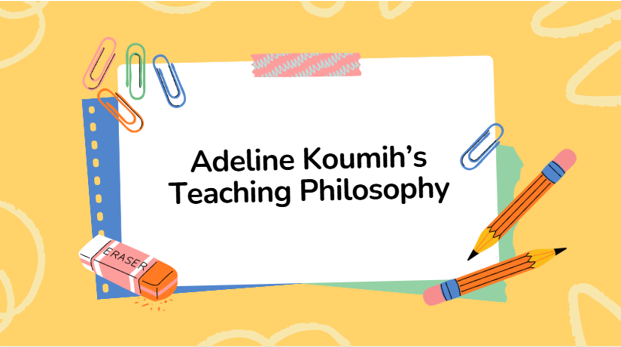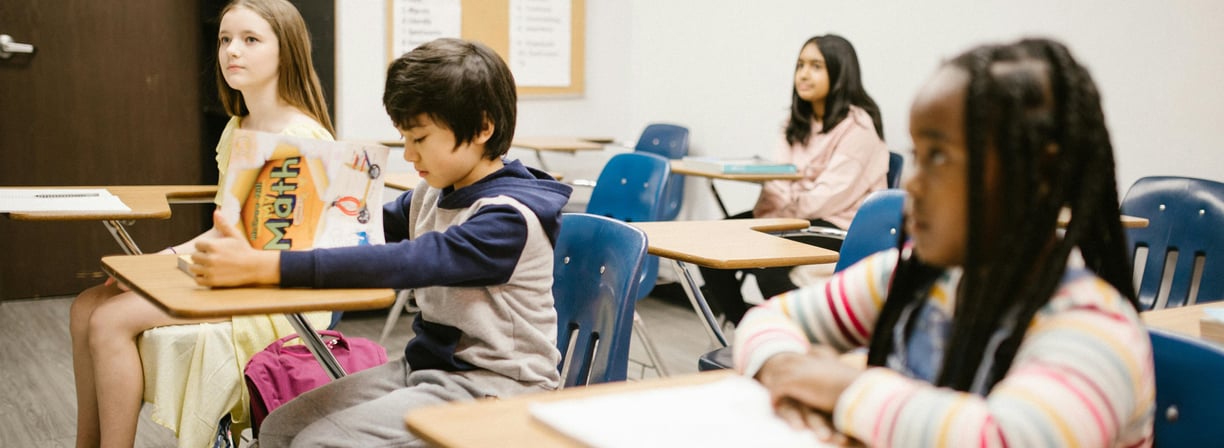

Introduction
I’m Adeline Koumih, a teacher candidate at the University of Ottawa pursuing a Junior-Intermediate Bachelor of Education in the Urban Communities Cohort major in Math. I’m Inspired by the biblical quote, "Train up a child in a way he should go even when he is old, he will not depart from it" (Proverbs 22:6), I believe in the crucial role of responsible adults, role models, and teachers in shaping children into responsible adults. My passion for working with children led me to transition from a bachelor’s degree in economics to a three-year advanced diploma program in Child and Youth Care at Algonquin College, where I gained valuable experience working with children of various ages and in diverse environments. As an Educational Assistant in both the Ottawa Carleton School Board and Ottawa Catholic School Board, I further honed my skills in guiding and supporting students through their educational journey. I am excited to continue this journey to become a dedicated and impactful teacher, helping to shape the future of the next generation.
My Teaching Philosophy Is.
Creating A Safe, Engaging, Equitable, Inclusive Thinking Classroom. Where Every Student Matters.
As an educator in Ontario, my teaching philosophy is rooted in fostering inclusive, student-centered, and inquiring -based learning experiences that support the development of critical thinking, creativity, and lifelong learning. I believe in creating a safe, engaging, and equitable learning environment where all students feel valued and supported in their educational journey. Guiding, leading, and teaching by example are foundational principles in my approach. I prioritize being present early, setting up the classroom, and greeting each student warmly. Collaboratively establishing classroom rules and expectations with students ensures a sense of shared ownership. I believe in respecting and valuing every student, actively participating in both indoor and outdoor activities.


Getting to know my students, focusing on the importance of students' names builds a positive class community. Learning how to pronounce their names ahead of time or have students write down how to pronounce their name on the class roster. Prioritizing being present early, setting up the classroom, and greeting each student warmly. Creating enough attractive space. The classroom is an environment that plays a role in learning just as much as the teacher and classmates do. The physical space will be very organized with visual elements on the walls, background music making the environment very calm, comfortable and relaxing. Creating a balanced learning environment which involves providing quiet spaces for focused work and collaborative areas for group activities. Reflecting cultural diversity in materials, setting clear guidelines for independent work, establishing routines for seeking help, and acknowledging diverse learning styles contribute to a supportive and inclusive atmosphere
Activities will be that which is inclusive of all students. For example, instead of the traditional family tree activity, students research a famous or fictional family.
Commitment to Equity and Inclusion, The Ontario Curriculum emphasizes equity and inclusion, and I am committed to ensuring a culturally responsive and anti-oppressive learning environment. I integrate diverse perspectives, texts, and learning materials to reflect students' lived experiences and identities. Additionally, I implement strategies from Culturally Relevant and Responsive Pedagogy (CRRP) to affirm students' voices and promote social justice.
Key Educational Theories Informing My Practice
Constructivism
My philosophy of teaching and learning is based on Constructivism (Piaget & Vygotsky). As a mathematics, science, and physical education teacher, I am passionate and dedicated to helping students become critical thinkers. Through these subjects, I would encourage them to ask questions, engage in hands-on experiments, face challenges, think deeply, and explore the world with curiosity and logic. I would encourage experiential learning, inquiry-based projects, and collaborative discussions that allow students to construct their understanding.
Differentiated Instruction (Tomlinson): I believe every student has unique learning needs, styles, and abilities. I would incorporate multiple means of representation, engagement and expression to accommodate diverse learners. Differentiated instruction is integral to Ontario’s Universal Design for Learning (UDL) approach, ensuring accessibility for all students, including those with special education needs. Tailoring reading materials to varying readability levels, adapting spelling and vocabulary lists, and utilizing auditory and visual resources address the diverse needs of students. Employing strategies like reading buddies and small group sessions ensures that concepts are reinforced for struggling learners and extended for advanced ones
Collaboration: Providing students with opportunities to collaborate in the natural world, the importance of collaboration becomes not just a lesson but a foundation for a future generation capable of working together to navigate the challenges of an interconnected world. Recognizing the uniqueness of each student, collaborative work ensures a deeper understanding of their strengths, challenges, and preferences in education. By encouraging students to share their ideas, we foster an inclusive learning environment where both teachers and students contribute to innovative lesson plans, address concerns, and provide mutual support. Display students’ work throughout the classroom and share the learning that’s happening at school with parents via video, apps or an e-newsletter, suggestions.
Experiential and Real-World Learning Theory (Kolb, 1984): Learning occurs through direct experience and reflection. Encourages hands-on activities like nature walks, field trips, and experiments. Example: Students learn about ecosystems by exploring a local pond, collecting samples, and analyzing them. During my practicum, I worked in a Grade 8 Science and Physical Education classroom. During one of our lab activities on microscopes, we took the students to a local pond to collect samples, which we then brought back to the lab for observation. Using the microscope, we explored various lenses and were amazed by the microscopic creatures we discovered. We also examined other human specimens, which further enriched the learning experience. The students were highly engaged and actively participated, making the lesson both enjoyable and educational. When students enjoy what they are learning, they become more motivated to attend school and actively engage in their education.
Physical Literacy Approach (Whitehead): Developing fundamental movement skills and confidence in physical activity leads to lifelong participation in fitness and sports. I emphasize skill progression, personal goal setting, and fostering a positive attitude toward physical activity. Ontario Curriculum Connection: Physical literacy is a cornerstone of the Health and Physical Education curriculum, ensuring students develop competence and confidence in movement. I integrate diverse sports, activities, and movement practices from various cultures, ensuring all students feel represented and included in physical education experiences.
Assessment and Growth Mindset: I would use a variety of assessment methods, including diagnostic, formative, and summative assessments, to track student progress and provide meaningful feedback. Inspired by Dweck’s Growth Mindset Theory, I would encourage students to embrace challenges, view mistakes as learning opportunities, and develop resilience in their educational journey.
Core Values of Education
The core values of education shape the way learning is delivered, experienced, and understood. These values guide teachers, students, and institutions in fostering meaningful and impactful learning. Here are some key core values:
1. Lifelong Learning: Education should inspire curiosity and a love for continuous learning. Example: Encouraging students to ask questions and seek knowledge beyond the classroom.
2. Critical Thinking & Problem-Solving: Encourages students to analyze, evaluate, and create solutions. Example: Engaging in debates, real-world case studies, or hands-on experiments.
3. Equity & Inclusion: Ensuring every learner has access to quality education regardless of background; Example: Adapting teaching methods to accommodate different learning styles and needs.
4. Integrity & Ethics: Teaching honesty, responsibility, and ethical decision-making: Example: Encouraging academic honesty and fostering discussions on moral dilemmas.
5. Respect & Empathy: Cultivating understanding, kindness, and appreciation for diverse perspectives. Example: Promoting cultural awareness through literature, discussions, or collaborative projects.
6. Collaboration & Community Engagement: Education should encourage teamwork and social responsibility. Example: Group projects, service learning, and community outreach programs.
7. Creativity & Innovation: Encouraging new ideas, curiosity, and self-expression. Example: Allowing students to explore projects of personal interest or engaging in arts-based learning.
8. Resilience & Perseverance: Teaching students to overcome challenges and learn from failure. Example: Growth mindset activities and outdoor challenges that build grit.
9. Environmental Stewardship Promoting sustainability and a connection to nature: Example: Outdoor learning activities, environmental projects, and ecological awareness lessons.
10. Personal and Social Responsibility; Encouraging students to be responsible for themselves and their contributions to society. Example: Leadership roles in school, volunteering, or civic education programs.
To conclude, below is my beliefs summary,
References:
Constructivist theory : https://www.simplypsychology.org/constructivism.html
Ontario ministry of Education: https://www.ontario.ca/page/ministry-education
Experiential Learning : https://www.aee.org/what-is-experiential-education
Collaborative Learning : https://teaching.cornell.edu/teaching-resources/active-collaborative-learning/collaborative-learning
Experiential Learning : https://www.aee.org/what-is-experiential-education
Youtube: What is Experiential Education?